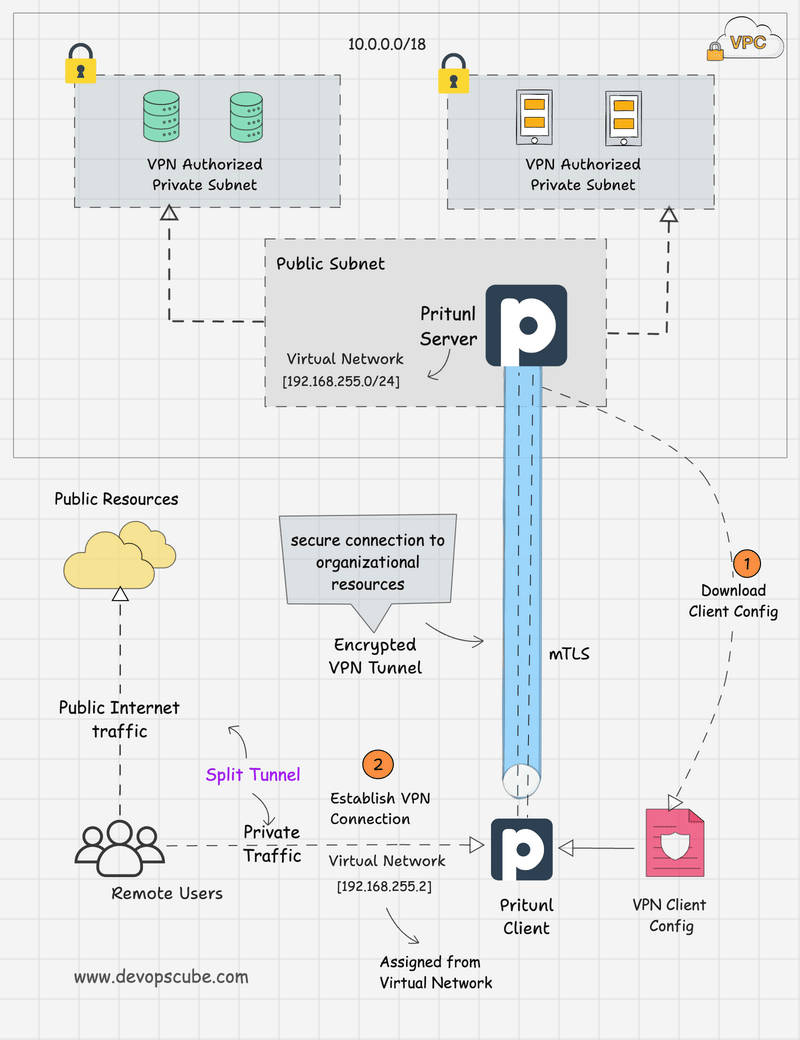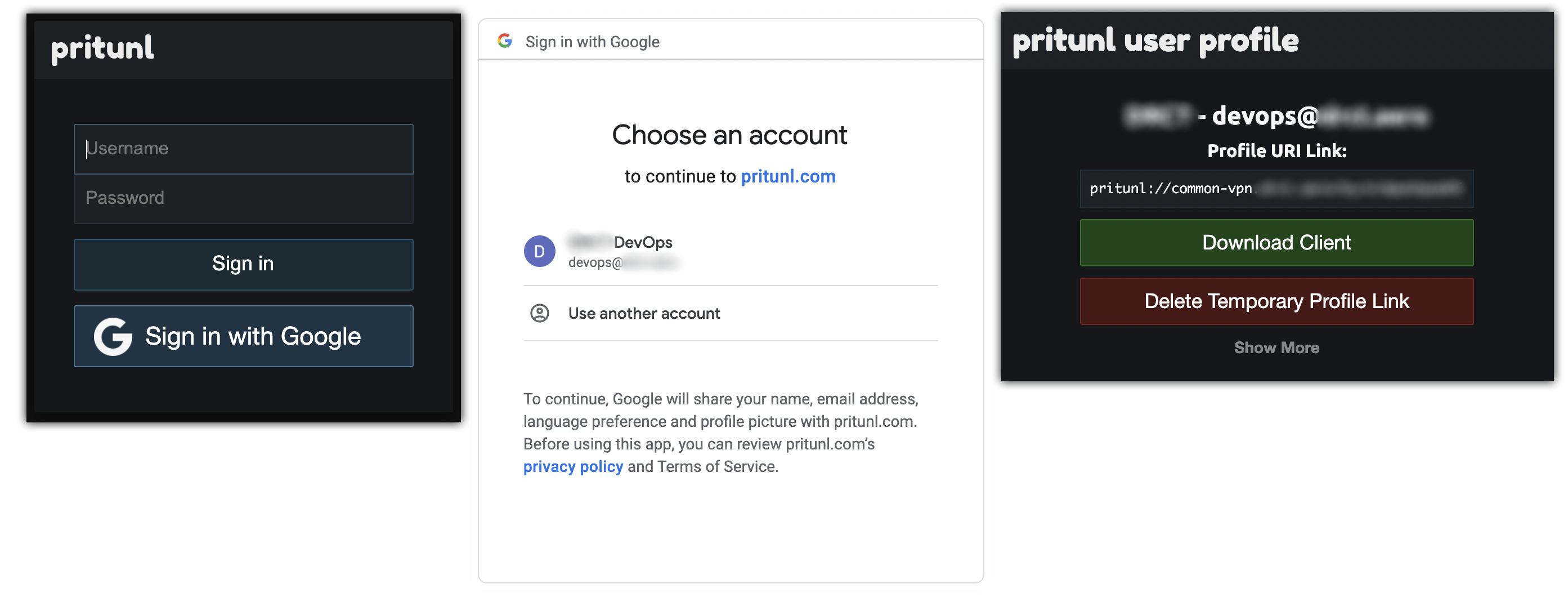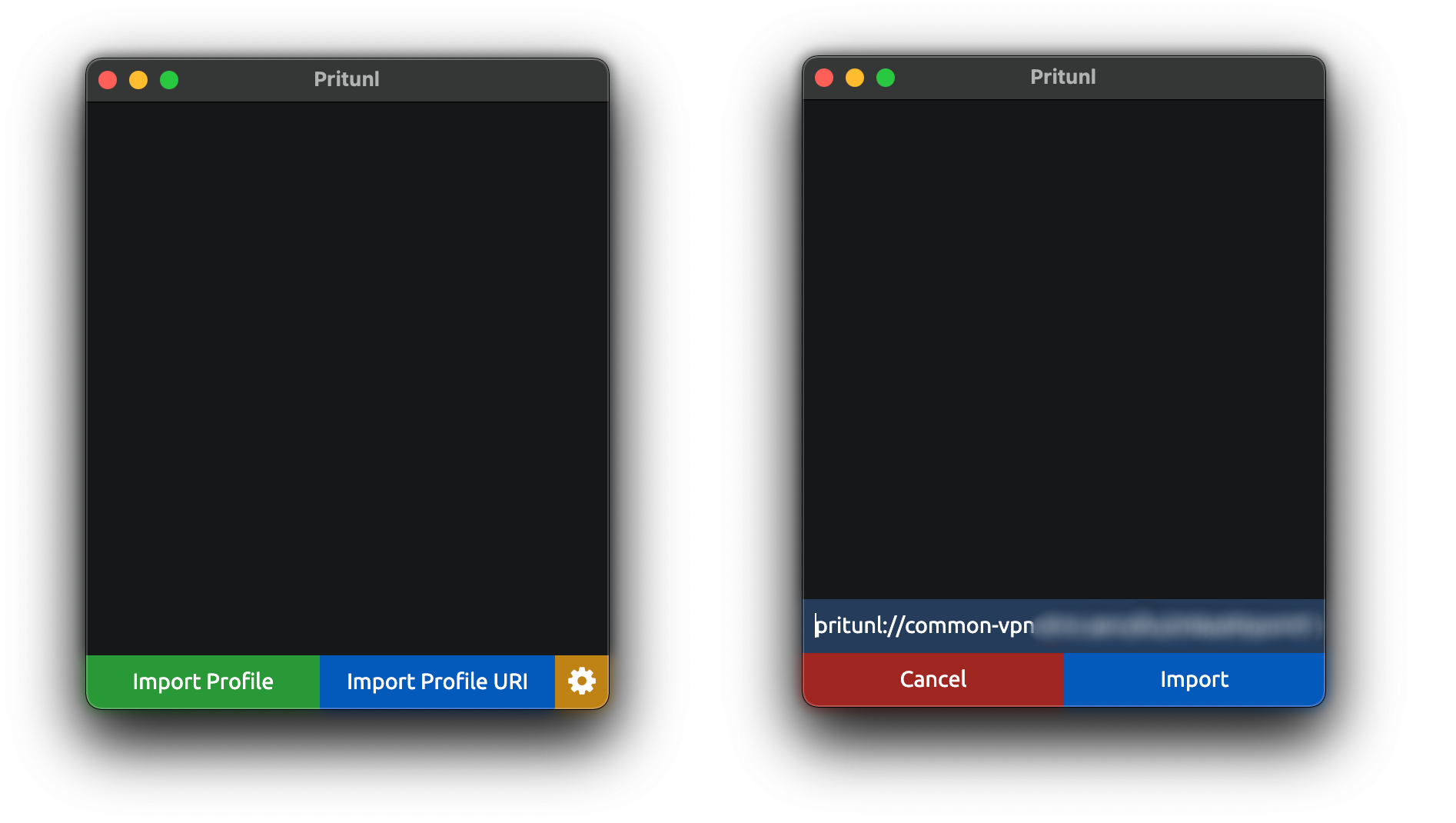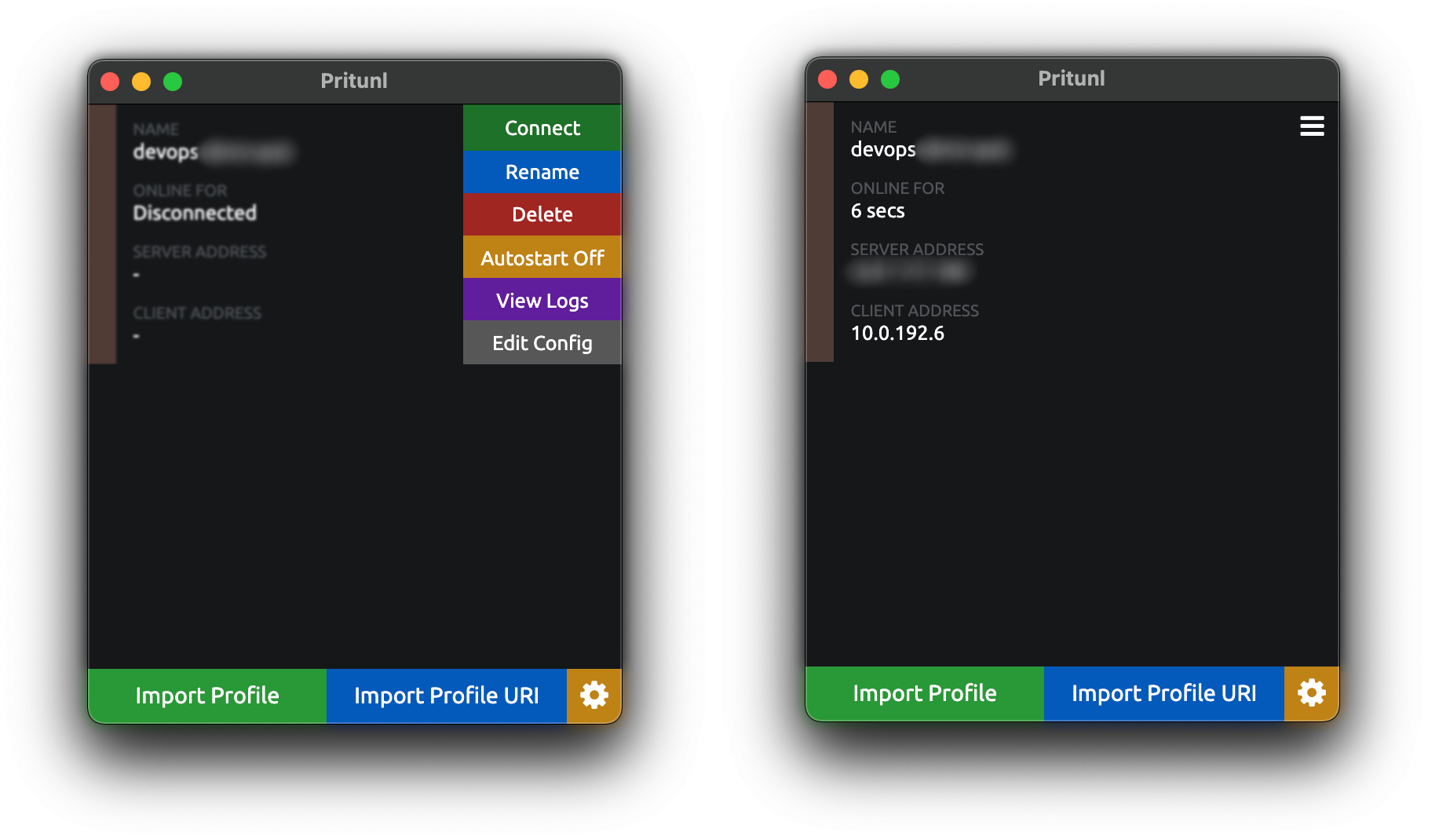VPN: Pritunl
By default, our network hosts are not accessible from the outside, VPN will allow you to access them via their private IP addresses.

TODO
- update guide for
terragrunt
Terrafrom setup
As a VPN server we use Pritunl. The EC2 instance pritunl-vpn where the server runs is deployed in common-vpc, so it has access to all vpc networks. More about the network architecture:
We used terraform to deploy the VPN server. The code is stored in the file terraform/aws/live/common/vpn.tf and relies on a custom module (module code: terraform/aws/modules/pritunl/).
Deploy
- upd
common_public_0data to fetch public subnet - add public ssk key to
aws_key_pair.common
main.tf
data "aws_subnet" "common_public_0" {
vpc_id = module.vpc.vpc_id
cidr_block = var.vpc_public_subnets[0]
}
resource "aws_key_pair" "common" {
key_name = "vpn-admin"
public_key = "ssh-rsa ******"
tags = merge(
var.tags,
{
Name = "vpn-admin"
},
)
}
variable "vpn_admins" {
type = list(object({
name = string
ip_list = list(string)
}))
sensitive = false
description = "Pritunl admins"
validation {
condition = alltrue([
for user in var.vpn_admins : alltrue([
for cidr in user.ip_list : can(
regex("^\\d{1,3}\\.\\d{1,3}\\.\\d{1,3}\\.\\d{1,3}/32$", cidr)
)
])
])
error_message = "Wrong admin IP list. Example: [\"82.82.82.82/32\"]."
}
}
variable "vpn_users" {
type = list(object({
name = string
ip_list = list(string)
}))
sensitive = false
description = "Pritunl users"
validation {
condition = alltrue([
for user in var.vpn_users : alltrue([
for cidr in user.ip_list : can(
regex("^\\d{1,3}\\.\\d{1,3}\\.\\d{1,3}\\.\\d{1,3}/32$", cidr)
)
])
])
error_message = "Wrong user IP list. Example: [\"82.82.82.82/32\"]."
}
}
locals {
vpn_admin_cidrs = concat([
for admin in var.vpn_admins : [
for ip in admin.ip_list : ip
]
]...)
vpn_user_cidrs = concat(local.vpn_admin_cidrs, [
for user in var.vpn_users : [
for ip in user.ip_list : ip
]
]...)
}
module "terraform-aws-pritunl" {
source = "../../modules/pritunl"
aws_key_name = aws_key_pair.common.key_name
public_subnet_id = data.aws_subnet.common_public_0.id
admin_cidrs = local.vpn_admin_cidrs
user_cidrs = local.vpn_user_cidrs
volume_extra_tags = {
Snapshot = "true"
}
tags = merge(
var.tags,
{
Name = "pritunl-vpn"
},
)
}
resource "aws_route53_zone" "home_lab" {
name = "home.lab"
tags = var.tags
}
resource "aws_route53_record" "common_vpn" {
zone_id = aws_route53_zone.home_lab.zone_id
name = "common-vpn.home.lab"
type = "A"
ttl = "300"
records = [module.terraform-aws-pritunl.elastic_ip]
allow_overwrite = true
}
Access
VPN is only accessible from IP addresses in the lists stored in terraform/aws/live/common/terraform.tfvars
vpn_admins = [
{
name = "Andrew Ozhegov"
ip_list = ["88.88.88.88/32"]
},
{
name = "Dante Aligieri"
ip_list = ["77.77.77.77/32"]
},
]
vpn_users = []
Currently, there are two types of users:
usershave access to the web interfaceadminsadditionally have ssh access to network instances
Backup & Restore
We use EBS Lifecycle Manager (DLM) to take a daily snapshot of the pritunl-vpn instance.
We store snapshots for the last 7 days. Terraform code aws_dlm_lifecycle_policy in the file terraform/aws/live/common/vpn_backup.tf
If necessary, we will use snapshot to roll back or restore the state of the vpn server. Step-by-step instructions for recovery from aws:
Restoring from an Amazon EBS snapshot or an AMI To reduce the recovery time and impact to dependent applications and processes, your restore process must consider the resource that it is replacing.
https://docs.aws.amazon.com/prescriptive-guidance/latest/backup-recovery/restore.html#restore-snapshot
resource "aws_iam_role" "dlm_lifecycle_role" {
name = "dlm-lifecycle-role"
assume_role_policy = <<EOF
{
"Version": "2012-10-17",
"Statement": [
{
"Action": "sts:AssumeRole",
"Principal": {
"Service": "dlm.amazonaws.com"
},
"Effect": "Allow",
"Sid": ""
}
]
}
EOF
tags = var.tags
}
#tfsec:ignore:aws-iam-no-policy-wildcards
resource "aws_iam_role_policy" "dlm_lifecycle" {
name = "dlm-lifecycle-policy"
role = aws_iam_role.dlm_lifecycle_role.id
policy = <<EOF
{
"Version": "2012-10-17",
"Statement": [
{
"Effect": "Allow",
"Action": [
"ec2:CreateSnapshot",
"ec2:CreateSnapshots",
"ec2:DeleteSnapshot",
"ec2:DescribeInstances",
"ec2:DescribeVolumes",
"ec2:DescribeSnapshots"
],
"Resource": "*"
},
{
"Effect": "Allow",
"Action": [
"ec2:CreateTags"
],
"Resource": "arn:aws:ec2:*::snapshot/*"
}
]
}
EOF
}
resource "aws_dlm_lifecycle_policy" "pritunl_vpn" {
description = "VPN server volume DLM lifecycle policy"
execution_role_arn = aws_iam_role.dlm_lifecycle_role.arn
state = "ENABLED"
policy_details {
resource_types = ["VOLUME"]
schedule {
name = "Last week of daily snapshots"
create_rule {
interval = 24
interval_unit = "HOURS"
times = ["23:45"]
}
retain_rule {
count = 7
}
tags_to_add = {
SnapshotCreator = "DLM"
}
copy_tags = true
}
target_tags = {
Snapshot = "true"
}
}
tags = merge(
var.tags,
{
Name = "pritunl-vpn"
},
)
}
Setup guide
Add user's IP to allowed list
terraform/aws/live/common/terraform.tfvars
vpn_users = [
+ {
+ name = "YourName"
+ ip_list = ["7.7.7.7/32"] # your ip
+ },
]
Setup VPN Client
-
Access portal:
- https://common-vpn.home.lab/ ->
Sign in with Google - Download Pritunl client and copy Profile URI Link
- https://common-vpn.home.lab/ ->

- Pritunl client:
Import Profile URI-> paste Profile URI Link

- Connect to VPN

- Done!